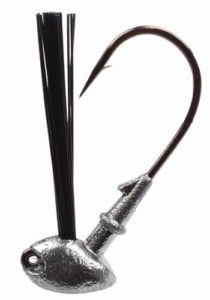How to Make a Brush Jig
 Are you looking to learn how to make a brush jig? You’ve come to the right place!
Are you looking to learn how to make a brush jig? You’ve come to the right place!
Jigs have been used to catch big bass for decades. They’re a proven fish catcher and are fun to use once you learn their subtle nuances.
Brush jigs aren’t made to fish only in and around brush, despite their name. They can be used just about anywhere a bass will hide, including rocks, weeds, docks and more.
As with most other bass jigs, brush jigs can be dressed with a variety of materials. The most popular of those materials is rubber or silicone.
Some people choose to pour their own brush jigs, using melted lead and a mold, such as the Do-It Molds BSH-3-SA Brush Jig mold. The SA model has 3 cavities and lets you pour jigs in 1/4, 3/8 and 1/2 oz. sizes.
If you prefer heavier jigs, in the 5/8 oz. to 1 oz. sizes, you can use the BSH-3-SLA mold. This mold also has 3 cavities.
What You’ll Need
Before you get started, you’ll need to gather up some materials and parts to make your jigs with. You’ll need lead, fiber weed guards and hooks for the jig itself.
After the jigs are poured, you’ll need powder paint, rubber skirt material or silicone skirt material, and either skirt bands or wire to hold the skirts in place. We’ll include a list of these items and links to each of them at the bottom of the article 🙂
As always, be sure to do everything safely! Wear gloves to prevent burns to your hands. Or, at the very least, use latex or similar gloves to keep the lead residue off your hands. Some people also like to wear a mask to prevent breathing in anything toxic while pouring the lead. Again, some choose not to wear a mask, but to simply make sure they are in a well ventilated area, as mentioned in the video below.
The video below will walk you through the rest of the process, including some great tips for prepping the mold and keeping the operation flowing without any problems.
Items used for this project:
- Do-It Brush Jig Molds
- VMC 60 Degree Jig Hooks
- Fiber Weed Guards
- Powder Paint
- Silicone Skirt Material
- Rubber Skirt Material
- Skirt Collars
- Hot Mill Gloves
- Bass Jig Trailers
If you enjoyed this post, please be sure to like it and share it with your friends.
If you’d like to learn how to Tie a Silicone Finesse Jig, click here.
And, as always, if you need any kind of lure-making supplies, be sure to visit our website, at http://lurepartsonline.com
